Evaluation of turmeric (Curcuma longa L.) genotypes for growth, yield and quality under rainfed condition of Arunachal Pradesh, India
Bạn đang xem bản rút gọn của tài liệu. Xem và tải ngay bản đầy đủ của tài liệu tại đây (253.83 KB, 8 trang )
Int.J.Curr.Microbiol.App.Sci (2019) 8(9): 619-626
International Journal of Current Microbiology and Applied Sciences
ISSN: 2319-7706 Volume 8 Number 09 (2019)
Journal homepage:
Original Research Article
/>
Evaluation of Turmeric (Curcuma longa L.) Genotypes for Growth, Yield
and Quality under Rainfed Condition of Arunachal Pradesh, India
P.S. Mariam Anal*
Department of Vegetable Science, College of Horticulture and Forestry, Central Agricultural
University, Pasighat, Arunachal Pradesh, India
*Corresponding author
ABSTRACT
Keywords
Turmeric,
Genotypes, Growth,
Yield, Curcumin,
Essential oil and
oleoresin
Article Info
Accepted:
04 August 2019
Available Online:
10 September 2019
Field experiments were conducted in randomized block design with three replications at
the Horticulture Experimental Farm, College of Horticulture and Forestry, Central
Agricultural University, Pasighat, Arunachal Pradesh for four seasons starting from the
year 2013-14 and ending in 2016-17. Total 12genotypes were taken for study including
one local and one national check. Observations were recorded for various growth, yield
and quality characters such as plant height (cm), number of tillers per plant, number of
days to maturity, rhizome yield per plant (kg), rhizome yield (t/ha), dry recovery (%),
curcumin content (%), essential oil (%) and oleoresin content (%). The data were analyzed
as per statistical procedure. In general during the four years of study the result revealed
significant variation for all the characters considered. Taller plant height was recorded in
genotype NDH-98, Megha Turmeric-1 and NDH 8. Higher number of tillers per plant was
associated with the genotypes NDH-98, NDH-79, PTS-12, TCP-64, Acc.-48 and the local
check Megha Turmeric-1. The genotype NDH- 98 recorded the highest rhizome yield per
plant and per hectare and it was significantly superior to all the other genotypes including
the National Check Prathibha and Local check Megha Turmeric-1 with few exceptions in
some years. The significantly higher dry recovery percentage of turmeric was recorded in
genotype NDH-8 while the lowest was exhibited in genotype PTS-8 with some exception
over the years. Higher curcumin content was recorded in genotype PTS-8, Acc.-48 (IISR
Pragati), SLP-389/1, NDH-8, NDH-79, NDH-98, PTS-12 including local check Megha
Turmeric 1. The variation in essential oil among the genotypes was found to be not
significant. The maximum oleoresin content was recorded in genotype NDH-8 which
remained at par to Acc.-79, SLP-389/1, NDH-79 and PTS-8 respectively.
Introduction
Turmeric (Curcuma longa L.) is one of the
important spice crop grown in India since
times immemorial. It is widely used in
ceremonies and religious functions. It is an
erect, herbaceous perennial belonging to the
family Zingiberaceae and native to South East
Asia (Chickarmane et al., 2003).Turmeric is
valued for its deep yellow colour and pungent
aromatic flavour due to the presence of
colouring matter ‘curcumin’ and a volatile oil
‘termerol’. It is also an important condiment
which finds a unique place in culinary arts and
619
Int.J.Curr.Microbiol.App.Sci (2019) 8(9): 619-626
as colouring agent in textile, food,
confectionary, cosmetics and drug industries,
of late in the preparation of anti-cancer
medicines.
Turmeric is a tropical crop and needs a warm
and humid climate with an optimum
temperature of 20 to 30oC for normal growth
and satisfactory production. It thrives best on
sandy loam or alluvial, loose, friable and
fertile soil rich in organic matter status and
having a pH range of 5.0 to 7.5. Alkaline soil
is not suitable for its cultivation. The crop
cannot withstand water logging. It grows at all
places ranging from sea level to an altitude of
1200 m above mean sea level. As a rainfed
crop turmeric needs a well distributed annual
rainfall of 250 to 400 cm for successful
production.
India is the major producer of turmeric and 4th
most important spice crop of India. In India it
is being cultivated in an area of 1,93,400 ha
with an annual production of 10,52,100 MT
and productivity of 5.44 MT/ha. In Arunachal
Pradesh it is raise in an area of 800 ha with an
annual production of 3800 tonnes and
productivity of 4.75 t/ha (Anon., 2017).The
average productivity of the crop is however
low in the state as against the National yield
average. Lack of suitable cultivar for a
particular agro-climatic condition is one of the
reasons for low productivity. Several studies
revealed existence of significant variability in
turmeric genotypes with regard to growth,
yield and quality attributes when grown under
different agro climatic conditions.
The performance of any crop or variety
largely depends upon its genetic makeup.
Further, the performance of the crop depends
upon climatic conditions of the region under
which they are grown. As a result, genotypes
which perform well in one region may not
perform well in other regions of varying
climatic conditions. Hence, it is very much
necessary to collect and evaluate all the
available genotypes in order to select suitable
and high yielding genotypes for a given agroclimatic
condition.
Considering
the
importance of turmeric, research on this crop
is very much necessary to find out the
suitability of different genotypes for a
particular region. Though wide genetic
variability exists in the crop with respect to the
growth and yield but not much work seems to
have been done on crop improvement through
the simple selection of the high yielding
genotypes (Singh and Prasad, 2006). Keeping
in view the above fact the present
investigation was carried out to find a suitable
genotype.
Materials and Methods
Twelve genotypes of turmeric including one
national check and local check (Acc.-48,Acc.79, SLP-389/1, NDH-8, NDH 79, NDH-98,
TCP-64 , PTS-12 , PTS-8 , PTS-55, Prathibha
(NC) and Megha Turmeric-1 (LC)) were
grown in randomized block design (RBD)
with three replications at Vegetable Research
Farm, College of Horticulture and Forestry,
Central Agricultural University, Pasighat,
Arunachal Pradesh for four seasons starting
from the year 2013-14 and ending in 2016-17.
The soil of the experimental field was sandy
loam in texture with a soil pH of 5.0-5.5, high
in organic carbon (1.5%), medium in available
nitrogen(327 kg/ha), low in available P2O5(35
kg/ha) and high in available K2O (360
kg/ha).Geographically it is located at latitude
of 28006’N, longitude 93032’E and altitude of
153 m MSL, hailing to the subtropical hot
humid climatic condition and is one of the
major production belts of turmeric. Healthy
rhizomes having 2-3 buds were planted at 30
cm apart in rows keeping 25 cm plant to plant
distance. The entire recommended package of
practices was followed to raise a good crop.
Five plants were randomly selected from each
plot to record observations on quantitative
620
Int.J.Curr.Microbiol.App.Sci (2019) 8(9): 619-626
characters like plant height (cm) and number
of tillers per clump. The days to maturity,
rhizomes yield (t/ha) and dry recovery were
observed and workout. The qualitative
characters like curcumin (%), essential oil (%)
and oleoresin content were also recorded. The
curcumin content was estimated as per the
methods of ASTA (Anon., 1968) proposed by
Manjunath et al., (1991).
Curcumin
(per cent) =
content OD value x 125 x 0.0025
0.42 x 0.1 x 1
The oleoresin content was calculated using the
following formula and expressed as per cent
(AOAC, 1975).
Oleoresin content (per cent) =
(air dry)
W2 – W1
x 100
10
Where,
W1 = weight of empty beaker
W2 = weight of beaker with air dried oleoresin
The essential oil content was estimated as per
the methods suggested by ASTA (Anon,
1968). The volume was measured and the oil
content was calculated as
Essential oil content
(per cent) =
Volume of
oil (ml)
Weight of
sample (g)
x 100
The mean values were subjected to statistical
analysis of data for each character as per
method given by Panse and Shukhatme
(1978).
Results and Discussion
Ten turmeric genotypes namely Acc.-48,
Acc.-79, SLP-389/1, NDH-8, NDH-79, NDH98, TCP-64, PTS-12, PTS-8, PTS-55were
evaluated in Randomized Block Design with
three replications along with National Check,
Prathibha and Local Check, Megha Turmeric1 during four years starting from 2013-14 to
2016-17 at Pasighat, Arunachal Pradesh.
Growth characters
The result revealed that signifcant variation in
growth parameters were observed among the
different genotypes during the four years of
study and in the pooled mean. The tallest plant
height was recorded in genotype NDH-98
(103.95 cm) which was statistically at par with
Megha Turmeric-1 (94.43 cm) and NDH-8
(93.02 cm) in all the years of investigation and
pooled mean with an exception in 2016-17.
Though, the shortest stature of plant was
observed in PTS-55 (85.70 cm) in 2013-14,
Acc.-48 (86.00 cm) in 2014-15, PTS-8 (60.33
cm) in 2015-16 and SLP-389/1 (64.00 cm) in
2016-17 and in (79.88 cm) pooled mean,
however, they were at par to each other. The
variation in plant height might be attributed to
genetic variation among the genotypes. Dhatt
et al., (2008), Singh et al., (2013) and Prasath
et al., (2016) also reported the differences in
plant height with different genotypes.
Maximum number of tillers per plant was
recorded in NDH-98 in all the years (4.73,
4.07 and 4.30) of study and pooled mean
(4.28) except in 2013-14 where NDH-79
(4.13) exhibited the highest number of tillers
per plant but remained at par to each other in
all the occasions. Again these genotypes
(NDH-98,
NDH-79)
did
not
differ
significantly with PTS-12, TCP-64, Acc.-48
and Megha Turmeric-1 in respect of number
of tillers per plant with few exceptions. The
minimum number of tillers per plant was
associated with the genotype Acc.-79 (2.87,
2.87, 2.73, 2.83 and 2.83) in all the four years
of investigation as well as pooled mean.
Similar variations in these characters among
the genotypes were reported by earlier
workers in turmeric and ginger under different
agro-climatic conditions (Babu et al., 1993,
Dhatt et al., 2008 and Rajyalakshmi and
Umajyothi, 2014) (Table 1).
621
Int.J.Curr.Microbiol.App.Sci (2019) 8(9): 619-626
Table.1 Plant height, number of tillers/plant and number of days to maturity as influence by different genotypes of turmeric
Genotype
Plant height (cm)
2013-14 2014-15 2015-16 2016-17
No. of tillers/plant
2013-14 2014-15 2015-16 2016-17
3.53
3.33
No. of days to maturity
Pool 2013-14 2014-15 2015-16 2016-17 Pool
mean of 4
mean of 4
years
years
3.47
3.57
202.07 212.33 208.00 226.00 212.10
Acc.-48
100.27
86.00
63.33
Pool
mean of 4
years
78.33
81.98
3.93
Acc.-79
106.20
94.00
70.33
64.67
83.80
2.87
2.87
2.73
2.83
2.83
208.80 216.67 205.00 221.33
212.95
SLP-389/1
98.53
89.67
67.33
64.00
79.88
3.60
3.40
3.07
3.17
3.31
200.93 201.73 198.00 216.00
204.17
NDH-8
110.73
99.00
73.67
88.67
93.02
4.07
3.73
3.27
3.43
3.63
214.60 222.80 208.67 229.00
218.77
NDH-79
103.17
96.23
60.67
83.67
85.94
4.13
4.33
3.60
3.67
3.93
207.93 213.33 206.00 224.33
212.90
NDH-98
115.80 115.00
81.67
103.33
103.95
4.00
4.73
4.07
4.30
4.28
210.00 218.27 208.00 230.00
216.57
TCP-64
90.50
88.33
73.33
86.00
84.54
3.87
3.80
3.40
3.73
3.70
191.17 215.00 200.00 218.00
206.04
PTS-12
98.03
87.00
63.00
79.33
81.84
3.87
3.67
3.33
3.47
3.59
202.93 217.67 203.00 221.33
211.23
PTS-8
107.37
94.67
60.33
72.33
83.68
3.40
3.13
2.87
3.13
3.13
202.53 216.33 188.67 218.00
206.38
PTS-55
85.70
96.00
67.33
72.33
80.34
3.20
3.60
3.07
3.20
3.27
187.27 215.00 196.67 221.33
205.07
Prathibha 100.17 93.33
(NC)
101.03 109.33
Megha
Turmeric1 (LC)
5.29
5.53
SEm±
70.00
74.33
84.46
3.33
3.20
3.00
3.17
3.18
206.33 215.00 201.33 219.33
210.50
75.67
91.67
94.43
3.93
3.73
3.33
3.50
3.62
209.67 215.00 197.33 221.33
210.83
3.8
3.59
4.55
0.26
0.31
0.26
0.19
0.25
4.08
3.15
4.57
1.45
3.87
CD at 5%
15.52
16.23
11.36
12.89
14.00
0.76
0.92
0.76
0.72
0.79
14.06
NS
15.6
5.45
11.70
CV %
9.03
10.01
9.74
9.53
9.58
12.13
14.87
13.73
12.34
13.26
4.79
5.85
5.32
1.52
3.98
622
Int.J.Curr.Microbiol.App.Sci (2019) 8(9): 619-626
Table.2 Yield and yield attributes of turmeric as influence by different genotypes
Genotype
Rhizome Yield/plant (kg)
Rhizome yield (t/ha)
Dry recovery (%)
2013-14 2014-15 2015-16 2016-17 Pool mean 2013-14 2014-15 2015-16 2016-17 Pool mean 2013-14 2014-15 2015-16 2016-17 Pool mean
of 4 years
of 4 years
20.57
21.23
Acc.-48
0.18
0.18
0.09
0.18
0.16
24.15
23.64
12.49
22.00
Acc.-79
0.17
0.18
0.08
0.15
0.15
23.22
23.53
10.66
17.54
18.74
SLP-389/1
0.14
0.15
0.05
0.11
0.11
19.04
20.20
7.22
13.55
NDH-8
0.25
0.25
0.06
0.12
0.17
32.76
32.97
8.62
NDH-79
0.27
0.27
0.07
0.12
0.18
35.50
35.74
NDH-98
0.27
0.27
0.17
0.23
0.24
35.63
TCP-64
0.11
0.14
0.05
0.09
0.10
PTS-12
0.18
0.18
0.06
0.12
PTS-8
0.14
0.15
0.05
PTS-55
0.21
0.21
Prathibha
(NC)
Megha
Turmeric-1
(LC)
SEm±
0.16
of 4 years
21.13
21.30
23.47
21.78
20.95
21.57
21.60
20.13
21.06
15.00
21.32
21.17
21.47
22.67
21.66
14.65
22.25
32.22
21.80
21.57
22.67
24.57
8.77
14.71
23.68
20.14
20.63
21.30
21.87
20.99
36.41
22.64
28.3
30.75
21.01
20.60
21.13
19.93
20.67
15.25
18.35
6.55
11.43
12.90
21.25
19.73
20.93
22.60
21.13
0.14
23.61
24.20
7.34
14.99
17.54
19.89
20.03
20.80
23.47
21.05
0.11
0.11
18.90
19.31
6.77
13.88
14.72
18.90
19.83
20.60
22.20
20.38
0.08
0.15
0.16
28.45
27.75
10.10
16.65
20.74
20.85
21.57
21.30
18.93
20.66
0.16
0.07
0.13
0.13
21.45
21.53
9.32
15.54
16.96
21.17
21.77
21.20
23.53
21.92
0.17
0.21
0.09
0.2
0.17
22.81
27.75
11.54
23.86
21.49
21.73
21
21.13
21.53
21.35
0.01
0.02
0.01
0.01
0.01
1.92
2.52
1.21
1.14
1.69
0.58
0.49
0.36
0.85
0.57
CD at 5%
0.04
0.06
0.03
0.04
0.04
5.62
7.39
3.54
4.11
5.16
1.71
1.42
NS
3.05
1.81
CV %
13.24
16.81
20.57
16.01
16.65
13.24
16.81
20.57
14.05
16.16
4.83
4.02
2.92
8.23
5.00
623
Int.J.Curr.Microbiol.App.Sci (2019) 8(9): 619-626
Table.3 Quality of turmeric as influence by different genotypes
Genotype
Curcumin (%)
Essential oil (%)
Oleoresin (%)
Acc.-48
6.20
7.00
11.12
Acc.-79
5.70
6.50
12.81
SLP-389/1
6.30
6.80
12.50
NDH-8
6.40
7.40
12.91
NDH-79
6.10
7.30
12.36
NDH-98
6.00
6.90
11.52
TCP-64
5.80
6.70
11.25
PTS-12
6.10
6.70
11.97
PTS-8
6.50
7.30
12.75
PTS-55
5.70
6.90
11.36
Prathibha (NC)
5.40
6.50
12.23
Megha Turmeric-1
6.20
6.90
11.46
SEm±
0.15
0.34
0.16
CD at 5%
0.52
NS
0.58
CV %
5.09
5.91
4.94
(LC)
The number of days taken from planting to
harvesting differed significantly among
turmeric genotypes. The genotype SLP-389/1
took minimum days (204.17) for maturation
while NDH-8 recorded maximum days
(218.77) for crop maturation followed by
NDH-98, Acc.-79 and Acc-48. The
differences in crop maturation among the
different genotypes of turmeric were also
reported by Hrideek et al., (2006), Singh and
Prasad (2006) and Singh et al., (2013).
genotypes. The genotype NDH-98 recorded
the highest rhizome yield per plant (0.27,0.27,
0.17, 0.23 and 0.24 kg) in all the four years of
study as well as in pooled mean and it was
significantly superior to all the other
genotypes in all the years with exception in
2013-14 and 2014-15 where it did not differ
significantly with NDH-8 and NDH-79
respectively. The yield per hectare also
followed the similar trend as that of rhizome
yield per plant with NDH-98 (35.63, 36.41,
22.64, 28.30 and 30.75 t/ha) recording the
maximum rhizome yield, which was
significantly superior over National Check
Pratibha and Local check Megha Turmeric-1.
Better growth and higher yield component
Yield attributes and yield
A perusal of Table 2 showed significant
variation in rhizome yield among the
624
Int.J.Curr.Microbiol.App.Sci (2019) 8(9): 619-626
contributed positively for the higher rhizome
yield in this genotype. The lowest rhizome
yield was recorded in genotype TCP-64
(15.25, 18.35, 6.55, 11.43 and 12.90 t/ha)
over the years of investigation and pooled
mean. Pirjade et al., (2007), Chaturvedi et al.,
(2010), Negi et al., (2012) and Singh (2013)
reported wide variability for rhizome yield
among genotypes of turmeric. A significant
difference in dry recovery of turmeric was
observed among the genotypes in all the years
of study with an exception in 2015-16. The
significantly higher dry recovery percentage
of turmeric was recorded in genotype NDH-8
(24.57 %) in four years pooled mean while
the lowest was exhibited in genotype PTS-8
(20.38 %) with some exception over the
years.
References
A.O.A.C. (1975).Official methods of
analysis. Association of official
Agricultural Chemists, Washington,
D.C. 12th Edn.
Anonymous (1968). Official Analytical
Methods.2nd Edn. American Spice
Trade Association, 38: 9-10.
Anonymous (2017). Horticultural Statistics at
a Glance. Govt. of India. Ministry of
Agri. and Farmers Welfare, Deptt. of
Agri., Cooperation and Farmers
welfare, Horti. Statistics Div.
Babu, N.K., Sasikumar, B., Ratnambal, M.J.,
George, J.K and Ravindran, P.N.
(1993). Genetic variability in turmeric
(Curcuma longa L.). Indian J. Genet.
Plant Breed. 53: 91-93.
Chaturvedi, O. P., Dwivedi, A.K. and
Tripathi, S.M., (2010). Varietal
performance of turmeric. The Asian J.
Hort., 4(2): 517-518.
Chickarmane, S., Rehse, T. and Prayer, K.M
(2003). Tracing the cultural and
botanical origins of turmeric (Curcuma
longa L.). Poster. Botany conf.org.in
Deshmukh, N.A., Gondane, S.U., Ingole, P.S.
and Patil, S.R (2009). Performance of
different promising cultivars of turmeric
under Nagpur condition. J. Soilsand
Crops, 19(1): 88-91.
Dhatt, A.S., Sadhna, A., Neena, C.,Sidhu,
A.S and Naveen G. (2008). Evaluation
of elite turmeric (Curcuma longa L.)
clones for growth, yield and quality
attributes. Indian J. Agric. Sci., 78(7):
589-591.
Hrideek, T.K., Kuruvilla, K.M., B
Indianumol, G.P., Menon, P.P.,
Madhusoodanan, K.J. and Thomas, J.
(2006). Performance evaluation of
turmeric (Curcuma longa L.) varieties
at higher elevation of Western Ghats. J.
Plantation Crops, 34(3): 178-180.
Kamble,
K.J.,
Ingale,
V.M.
and
Quality parameters
The highest curcumin content was recorded in
genotype PTS-8 (6.5%) which remained at
par to Acc.-48 (IISR Pragati), SLP-389/1,
NDH-8, NDH-79, NDH-98, PTS-12 and local
check Megha Turmeric-1 but significantly
superior to rest of the other genotypes (Table
3). The variation in curcumin content among
different cultivars could be related to the
genetic character of the cultivars. The
differences in curcumin content among the
different genotypes was reported earlier by
Rao et al., (2006), Deshmukh et al., (2009),
Kamble et al., (2011) and Singh et al., (2013).
Though variation in essential oil among the
genotypes was observed with maximum
recording in genotype NDH-8, however, the
differences were found to be not significant.
The maximum oleoresin content was recorded
in genotype NDH-8 (12.91%) which
remained at par to Acc.-79, SLP-389/1, NDH79 and PTS-8 but significantly higher to other
genotypes. From the present study, it can be
concluded that genotypes NDH-98 and NDH8 performed better in terms of yield and
quality respectively in Arunachal Pradesh.
625
Int.J.Curr.Microbiol.App.Sci (2019) 8(9): 619-626
Kalendhonkar,
D.P.
(2011).
Comparative study of curcumin
extraction from turmeric varieties
grown in Maharashtra. African J. Food
Sci. 5(14): 780-789.
Manjunath, M.M., Sattigeri, V.V and
Nagaraj, K.V (1991).Curcumin in
turmeric. Spice India, 4(3): 7-9.
Negi, R.S., Baghel, K.S. and Gautham, U.S
(2012).
Evaluation
of
turmeric
(Curcuma longa L.) varieties for their
suitability to Kaymore plateau and
Satpura hills agroclimatic zone of
Madhya Pradesh. Life Sci., Bull., 9(1):
179-180.
PanseVG, Sukhatme PV (1967) Statistical
methods for agricultural workers, Ind
Coun Agric Res New Delhi, pp 155
Panse,
V.G
and
Sukhatme,
P.V.
(1978).Statistical
methods
for
agricultural workers. 3rd edn., ICAR,
New Delhi, pp 347.
Pirjade, F.N., Jogdande, N.D., Nandre, D. R.,
Ghawade, S, M. and Patil, P.A (2007).
Varietal performance of turmeric. PlantArchives, 7(1): 363-364.
Prasath, D., Eapen, S.J., and Sasikumar, B.
(2016).Performance
of
turmeric
(Curcuma longa) genotypes for yield
and root-knot nematode resistance.
Indian J. Agric. Sci. 86(9): 1189-1192.
Rajyalakshmi, R. and Umajyothi, K. (2014).
Evaluation
of
ginger
(Zingiber
officinale Rosc.) varieties in high
altitude and tribal zone of Srikakulam
district of Andrapradesh. J. Spices and
Aromatic Crops, 23(2):258-261.
Rao, A.M., Rao, P.V. and Reddy, Y.N
(2006). Growth analysis and curcumin
content of long- medium and short
duration turmeric (Curcuma longa L.)
genotypes. J. Spices and Aromatic
crops, 15(1): 42-47.
Singh, A.K (2013). Evaluation of turmeric
(Curcuma longa L.) genotypes for yield
attributes, yield and reaction to foliar
diseases. J. Spices and Aromatic Crops,
22(2): 238–240.
Singh, B.K., Ramakrishna, Y., Deka, B.C.,
Verma, V.K. and Pathak, K.A. (2013).
Varieties and planting dates affect the
growth, yield and quality of turmeric
(Curcuma longa L.) in mild-tropical
environment. Veg. Sci., 40(1): 40-44.
Singh, S.P. and Prasad, R. (2006). Studies on
varietal performance of turmeric
(Curcuma longa L.). Int. J. Plant Sci.,
1(1): 22-23.
Singh, Y., Mittal, P and Katoch, V.
(2003).Genetic
variability
and
heritability in turmeric (Curcuma longa
L.). Himachal J. Agri. Res. 29: 31-34.
How to cite this article:
Mariam Anal, P.S. 2019. Evaluation of Turmeric (Curcuma longa L.) Genotypes for Growth,
Yield and Quality under Rainfed Condition of Arunachal Pradesh, India.
Int.J.Curr.Microbiol.App.Sci. 8(09): 619-626. doi: />
626
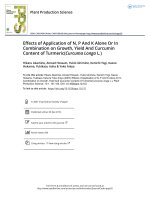

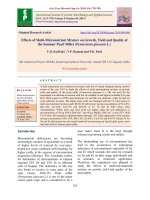
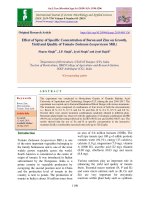
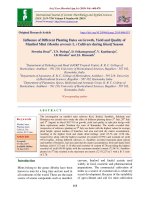
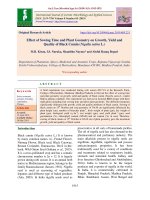


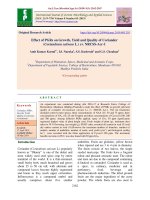
![Studies on correlation and path analysis for grain yield and quality components in foxtail millet [Setaria italica (L.) Beauv.]](https://media.store123doc.com/images/document/2020_01/09/medium_dyd1578574836.jpg)